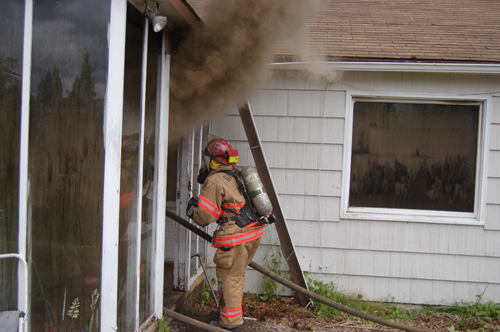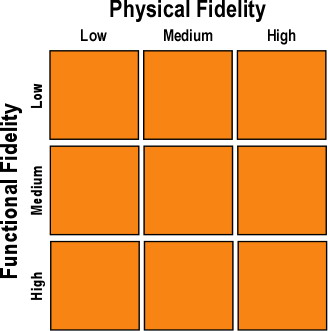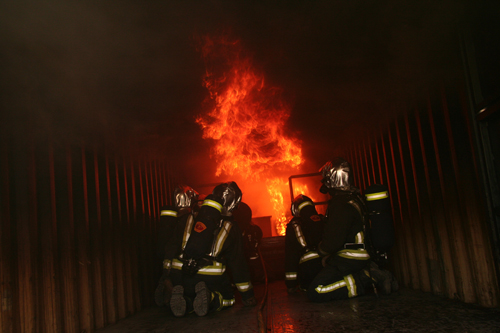Live Fire Training:
Important Questions
In several recent posts (Training Fires and “Real” Fires and Live Fire Training in Purpose Built Structures, I emphasized that all live fire training is a simulation. Fidelity is the extent to which the simulation replicates reality.
Figure 1. Training in an Acquired Structure

Note: Ed Hartin Photo
The Questions
Some firefighters and fire officers subscribe to the belief that use of acquired structures with realistic fuel loading is the only way to develop the necessary competence and skills to operate safely and effectively on the fireground. However, current standards such as National Fire Protection Association (NFPA) 1403 Standard on Live Fire Training (2007) places specific constraints on fuel types and loading. Some departments are faced with environmental constraints that preclude burning Class A fuel for structural live fire training and consequently use gas fired structures (or don’t conduct live fire training at all). Most departments who have access to purpose built structures and props for structural live fire training are limited to a single type of facility (due to economic constraints). This gives rise to an interesting set of questions:
- What degree of simulation fidelity is necessary to develop the knowledge and skills necessary for safe and effective operation on the fireground?
- What are the key elements of fidelity for various learning outcomes such as 1) developing understanding of fire development in a compartment, 2) dynamic risk assessment, inclusive of recognizing critical fire behavior indicators, 3) selecting appropriate fire control techniques, 4) developing competence and confidence when operating in a hazardous environment, 5) developing skill in nozzle operation and technique, 6) evaluating the effect of tactical operations.
- Is live fire training the only or most effective simulation method for achieving these learning outcomes? If so, what type of simulation will safely provide the required degree of fidelity? If not, what other simulation method may be used in place of, or in addition to live fire training to provide the required degree of fidelity?
I believe that effective performance under stressful conditions requires substantial training in a realistic context. However, the answers to the preceding questions have not yet been determined. What we have is a great deal of strongly held opinion without supporting discipline or task specific evidence.
Dimensions of Fidelity
As discussed in Training Fires and “Real” Fires, fidelity can be examined in a number of different ways, but one simple approach is to consider physical and functional characteristics of the simulation. Physical fidelity is the extent to which the simulation looks and feels real. Functional fidelity is the extent to which the simulation works and reacts realistically.
Figure 2. Two-Dimensional Fidelity Matrix

However, this simple model provides limited guidance when examining questions related to live fire training. Here it is necessary to consider: What are the key elements of physical and functional fidelity necessary to support the specific learning outcomes intended from a given training evolution?
In A Handbook of Flight Simulation Fidelity Requirements for Human Factors Research, Rehman (1995) describes three purposes of aircraft flight simulation: 1) provide practice on specific skills, 2) reinforce acquisition and use of job-relevant knowledge, or 3) to evaluate a system or new concept. The fidelity requirements for each of these three purposes may be quite different. In addition, fidelity applies to the simulator itself, the participants, and related or events external to the simulator. In a flight simulator, each subsystem of the simulator (e.g., cockpit layout, audio, motion) has specific fidelity characteristics that must be considered as illustrated in Figure 3.
Figure 3. Flight Simulator Subsystem Fidelity Characteristics

Note: Adapted from A Handbook of Flight Simulation Fidelity Requirements for Human Factors Research.
How might these concepts be applied to evaluating fidelity requirements for live fire training? Determining the answers to the questions posed in this post will require a significant research effort (and related funding). However, the first step in this process is to clarify, refine, and tightly focus the questions that this research needs to answer.
My next post will examine this interesting topic a bit further.
An Interesting Puzzle
Closely related to the topic of simulation fidelity, I was provided with an interesting puzzle by my friend Roy Reyes of the Swedish Civil Contingencies Agency. He forwarded me the following photo (Figure 4) from a fire behavior instructor course that he had conducted in Valencia, Spain. His first question was what do you see in the photo?
Figure 4. Participants Conducting Fire Behavior Demonstration 2

Note: Roy Reyes Photo
The second question is a bit more specific, why are the flames in the hot gas layer in the center, and not across the entire width of the compartment?
The answer to this question provides an important learning opportunity related to how simulator and simulation design impact on fidelity and the importance of the instructor in establishing context.
I will come back to these questions in my next post!
Ed Hartin, MS, EFO, MIFIreE, CFO
References
National Fire Protection Association (NFPA). (2007) NFPA 1403 Standard on Live Fire Training Evolutions. Quincy, MA: Author.
Rehman, A. (1995). A handbook of flight simulation fidelity requirements for human factors research, Report Number DOT/FAA/CT-TN95/46. Retrieved July 6, 2009 from http://ntl.bts.gov/lib/000/800/858/tn95_46.pdf
Tags: live fire training, NFPA 1403, simulation



July 16th, 2009 at 10:31
[…] Simulations: Key Elements of Fidelity Several earlier posts (Training Fires Versus Real Fires, Live Fire Training: Important Questions) introduced the concepts of live fire training as simulation, physical fidelity, and functional […]
January 24th, 2012 at 14:38
[…] • American Heat Video, “NFPA 1403 and the Boulder (CO) Incident.” • Live Fire Instructor Standards for the states of Illinois, Florida, North Carolina, Iowa, Kentucky, Pennsylvania, New York, and New Jersey. • NFPA 1403, available at http://www.nfpa.org/. • http://www.cdc.gov/niosh/rehome.html/. Brian P. Kazmierzak is a16-year veteran of the fire service. Since 1994, he has been employed by the Clay Fire Territory, South Bend, Indiana, where he is division chief of training and safety. He is the MABAS Division 201 Tactical Rescue Team Task Force leader and a hazmat specialist for FEMA’s US&R IN-TF1. He has two fire service related associate’s degrees and a bachelor’s degree in fire service administration, and is a recent graduate of the National Fire Academy’s Executive Fire Officer Program. He is the Close Calls editor for www.firefighterclosecalls.com. Boulder firefighters killed in accident 30 years ago to be remembered at ceremony The Boulder Fire Department will hold a remembrance ceremony for two firefighters who died during a training exercise on Jan. 26, 1982. The ceremony will be held on Thursday, Jan. 26, at Fire Station 3, 1585 30thSt. in Boulder. Thirty-year-old William J. Duran of Broomfield and 21-year-old Scott L. Smith of Longmont were inside an abandoned garage in north Boulder that was being used for a live-fire training exercise. The fire burned out of control, and the two men lost their lives. Two other firefighters, Cyrus E. Pinkerton and Daniel J. Cutler, were injured during the training. They both recovered. The accident prompted a major change in national fire training standards that are still in place today.“The Boulder Fire Department has never forgotten the sacrifice of Firefighters Duran and Smith or the important lessons learned about providing safe live-fire training for firefighters,” said Boulder Fire Department Chief Larry Donner. “We are honored to pay our respects to the firefighters and their families on this important anniversary, and we invite the community to join us.” The commemoration is open to the public. Seating begins at 9 a.m., and the ceremony starts at 10 a.m. The families of the fallen firefighters will be in attendance. Wreaths will be laid at the gravesites after the ceremony. » […]